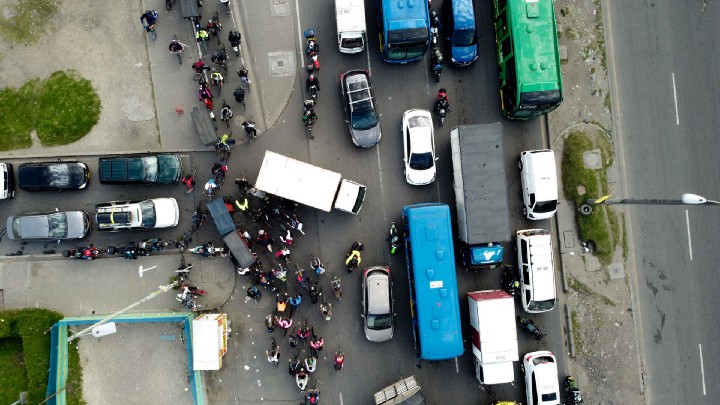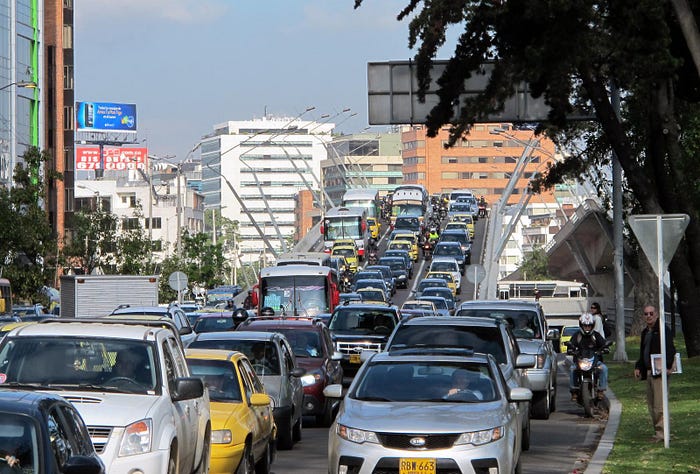
Congestion pricing is one of the most common-sense tools to curbing traffic, reducing tailpipe emissions and creating a more efficient transportation system that gets people where they need to go. It’s also extremely politically contentious, especially in cities in the United States, where drivers often believe that they should not have to pay for the road space they use, nor for the other negative externalities of automobile use.
Recent headlines, sparked by the latest news from New York City’s battle over implementing congestion pricing, make arguments from “congestion pricing hurts the middle class” to “congestion pricing will ruin our cities.” What these headlines ignore is that if implemented thoughtfully, congestion pricing has the proven potential to reduce congestion, make a dent in emissions and reshape the way our transportation systems work by shifting our own behavior toward more sustainable and equitable choices. Additionally, revenue from congestion pricing can be, as proposed in New York City, used to fund transit improvements that will expand benefits for riders and increase frequency, coverage and overall quality of service, thereby providing a sustainable and accessible alternative to driving.
If adequate alternatives exist, congestion pricing has the potential to address our greatest mobility challenges and help cities work toward broader goals, but the current model for implementing charging is outdated (and that’s being generous). Typical cons to congestion pricing include massive operating costs that can eat up half the revenue generated, as seen in London, as well as infrastructure and technological woes — gantry-based setups that use sensors and cameras to keep an eye on motorists require a lot of construction for tech that doesn’t allow much flexibility in charging or changing the chosen geography. And while gantries may work for highways, they’re less welcome in denser urban areas where there’s already a premium on space. It’s clear that we need a more flexible way of implementing congestion pricing that allows for more learning, and dynamic pricing without bulky tech.
With the proliferation of smartphones, apps provide one such remedy — just think about how transportation network companies like Uber and Lyft use apps to route drivers and determine how much to charge passengers. This theory is being put to the test in a new pilot in Bogotá, Colombia. The city’s recent ParceGo pilot demonstrates a viable way to circumvent these issues by developing a nimble, low-cost and flexible demand-side tool that is within reach of every city.
Bogotá’s App-Based Congestion Pricing Experiment
For the last twenty years, Bogotá has been hailed for revolutionary improvements in public transportation, cycling and walking. At the same time, the city stubbornly remains among the most traffic-plagued in the world, even despite measures to mitigate congestion like Pico y Placa (a system for travel restriction based on license plate numbers), which was introduced in 1998.
To further tame traffic, Bogotá upped the ante with Pico y Placa Solidario (“Solidarity Plate Restriction”), a new scheme that complements Pico y Placa, encourages ride sharing and creates exemptions for essential workers during times of need. Some of the revenue generated will go toward funding public transportation and micromobility. Since implementing Pico y Placa Solidario, however, the city has experienced challenges, mostly logistical, related to enforcement (e.g., communicating additional rules, signing up for the program, verifying exemptions).

To more proactively address these challenges with the aid of technology, as well as to test the feasibility of an app-based model, Bogotá partnered with ClearRoad, a private company specializing in building congestion pricing solutions, and Cornell Tech to initiate the pilot. Rather than using license plate numbers and gantries, the pilot capitalized on the wide availability of smartphones. Over 200 volunteer drivers were encouraged to sign up and log their trips using the specially-designed ParceGo app — an additional step, but one that users adopted seamlessly.
Another aim of the pilot, which ran for three months and ended on July 1, 2022, was to use the traffic and trip data gathered via the app to determine opportunities for better congestion management and optimal fair pricing strategies. The ParceGo app-based model of congestion pricing used real-time data to measure trip distance, the time of day at which trips are taken, specific roads or locations, trip types (e.g., commute, errand) and more, representing a major step up from traditional congestion pricing technology. With this information, pricing can become dynamic as it responds to demand for road space (i.e., price can respond to congestion levels more closely). Cornell Tech will analyze the data and travel behavior to present to the city.
During the pilot, users recorded over 600 trips taken per day, identifying trips taken in the central business district as well as in 14 other highly-congested main corridors. Preliminary results reveal that 41% of the recorded trips were taken by car and that 90% of the total trips occurred in the most congested areas of the city.
Users’ experience with the app was also surveyed after the pilot concluded. Overall, users felt positive about using the app, with 97% reporting they were comfortable sharing their information because of the data protection measures included in the app. Participants also rated the app as easy to use and generally liked how they were able to access the information they recorded to become more informed and mindful of their driving behaviors.
While an in-depth analysis is forthcoming, the success of the pilot demonstrates the feasibility of using app-based technology to unlock a more flexible, demand-based and equitable way to implement congestion pricing.
The Future of Dynamic Congestion Pricing
Congestion pricing has the potential to address some of our greatest mobility challenges while also helping us create a more sustainable, fair and efficient transportation system that gets people where they need to go safely and affordably. But we need a more flexible, dynamic way of implementing congestion pricing that enables quick piloting, price adjusting and reacting directly to current travel behavior.
The ParceGo pilot in Bogotá demonstrates that it is possible for cities to move away from expensive, slow-moving congestion pricing models that depend on physical infrastructure toward a more agile, app-based mechanism that allows for effective travel demand management.
The original version of this article appeared on The New Normal—The NUMO Blog.
Carlos F. Pardo is a Senior Advisor for NUMO, the New Urban Mobility alliance.
Frederic Charlier is Founder and CEO of ClearRoad.
NUMO, the New Urban Mobility alliance, is a global organization that channels tech-based disruptions in urban transport to create joyful cities where sustainable and just mobility is the new normal. Founded in 2019 as an outgrowth of the Shared Mobility Principles for Livable Cities, NUMO convenes diverse allies and leverages the momentum of significant revolutions in mobility to target urban issues — including equity, sustainability, accessibility and labor — impacted by the shifting transportation landscape.






